![]()
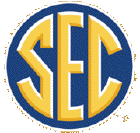 | - 1933 - |  |
![]()
First Round: (Friday, February 24, 1933)
Game 1: Alabama 41, Sewanee 28
Game 2: Tulane 46, Georgia 22
Game 3: Kentucky 49, Ole Miss 31
Game 4: Louisiana State 57, Auburn 33
Game 5: Tennessee 30, Georgia Tech 24
Byes: Mississippi State, Vanderbilt, Florida
Quarterfinals: (Saturday, February 25, 1933)
Semifinals: (Monday, February 27, 1933)
Finals: (Tuesday, February 28, 1933)
Game 12: Kentucky 46, Mississippi State 27
![]()
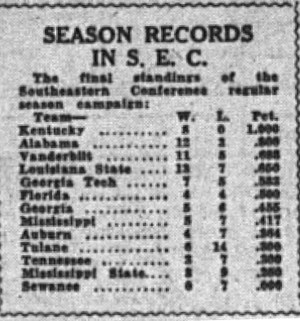 |
The other team considered as a title-contender was Alabama, which was considered to have an easier bracket than the Wildcats. Others mentioned included Vanderbilt and Louisiana State. The L.S.U. Tigers were highly anticipated, owing to the high scoring feats of two sophomores, Nathan Blair who entered the tournament as the highest scoring forward in the field (176 points in 20 games), and Malcolm "Sparky" Wade who had set a scoring record (193 points) for any player in the South up until that time.
Wade made a national splash even before setting foot on L.S.U.'s campus, as he led his Jena (L.A.) high school team to the championship game of the High School national tournament in Chicago in 1930, before being beaten by an Athens (TX) Hornets team led by Freddie and Bennie Tompkins
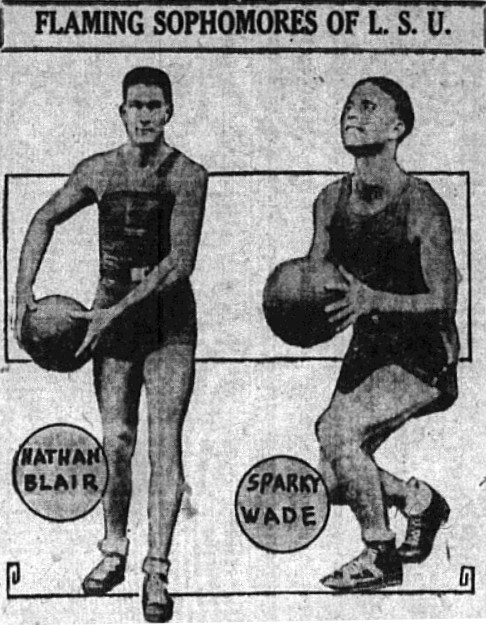 |
L.S.U. has been getting stronger from week to week and in its last several games has been piling up an amazing number of points. The Tigers should be at their peak in the tourney, and will give plenty of trouble. |
The Atlanta Journal's Morgan Blake considered the Friday afternoon session to be a bargain. Noted Blake:
"Atlanta youngsters are getting a great break today. For the sum of two bits, otherwise known as a quarter of a dollar, they can see the entire afternoon basket ball program, including three games, at the City Auditorium.
"And three of the teams competing before supper are Kentucky, Alabama and L.S.U., rated the best in the competition.
"The aforesaid 25 cents is the balcony admission price for the afternoon shows, while 50 cents get you a seat downstairs. The evening shows cost 50 cents in the balcony and $1 below." - ("Sportanic Eruptions: Insanity in the Offing," by Morgan Blake Atlanta Journal, February 24, 1933.)
Blake went on to be thankful that the opening day only had five games, instead of the larger fields in years past. He wrote: "This department is grateful that there were only five game on the opening day's program instead of eight, as has been the case in tournaments past. Five games make a feast, eight make an orgy. After sitting through eight games on opening day in the past, we have never been able to sleep that night. After seeing five today we hope to sleep at least two hours."
A two-man referee crew was used throughout the course of the tournament. Olney "Bowser" Chest returned for his third straight Atlanta tournament while George Wood of Florida, who had earlier refereed the 1930 tournament was returning for his second go-round. Noted the Atlanta Journal's Ole Timer about the officials: "Both of them are young enough and fast enough to keep up with the play, and are strict without being autocratic. I trust there will be less complaining by coaches than has been the case in the past. To listen to the plaintive wails emanating as though from severe digestive disorder, one would have judged that every team which lost a game had been victimized by the officials." ("The Lamp of Experience," by Ole Timer, Atlanta Journal February 23, 1933.)
Ole Timer also noted that there was a new rule in effect which limited foul line pivoting (?). The Atlanta Journal scribe thought this would limit the work of L.S.U.'s big man Jack Torrance and Tennessee's Robert Stafford, and suggested the rule would have affected Alabama's Lindy Hood from previous tournaments.
![]()
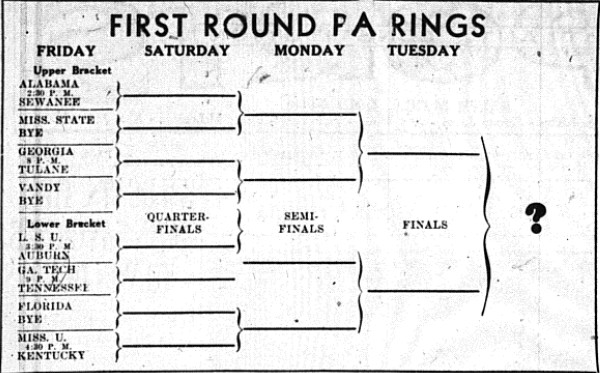 |
Friday, February 24, 1933 - First Round
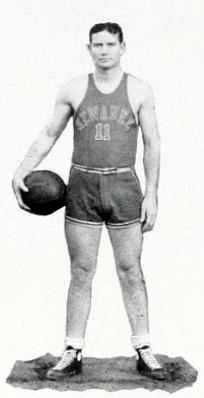 |
|
|
"Georgia's Bulldogs, crippled by the loss of Joe Chandler, star guard, will be called upon to defend their championship won in the Atlanta tournament last year.
"Chandler, who was unable to play in the Bulldog's last two games is in the University Infirmary suffering from a severe attack that has threatened him for sometime. His condition is not regarded as serious." - ("Bulldogs Minus Joe Chandler In Tourney," Atlanta Journal, February 24, 1933.)
|
|
"Georgia, having lost a center and a star guard since the season opened, was helpless before Tulane, a team the Bulldogs had already beaten twice. This game was one of the worst ever played in the tournaments here. The players were rolling and tumbling around and over one another like circus performers, only not so gracefully. The officials almost blew the batteries of their whistles down they had to use them so often.
"A dire fate apparently awaits all champions of these Atlanta tournaments. Alabama won the title in 1930 and went out in the first round in 1931. Maryland, champion in 1931, was eliminated in the first round in 1932. And Georgia took a tumble in the first day's play in this one after capturing the title last year." - ("Sportanic Eruptions: Vale Tech And Georgia!," by Morgan Blake Atlanta Journal, February 25, 1933.)
Game 3: Kentucky 49, Ole Miss 31
|
|
"The class teams of the first day undoubtedly were L.S.U. and Kentucky, the former the more spectacular and the latter slightly smoother and looking every inch the favorite that it has been made." - (Atlanta Journal, February 25, 1933.)
 |
|
|
"Sparky Wade, Huey Long's pet Tiger, stole the show Friday in the opening afternoon of the tournament. This little guard who during the pre-tourney campaign led the conference scorers, took the form of dynamite at the very outset against Auburn, and was one continuous explosion until the final whistle. His "monkey ball" shot, a way to describe his antics of looping the basket while in midair after a long dribble down the middle of the court, was the outstanding color play of the afternoon's three games." - ("Tourney Notes," by Byron Hollingsworth Atlanta Journal, February 25, 1933.)
"If L.S.U. goes to the finals it is expected that Huey Long will leave the senate flat and fly to Atlanta to witness the finish. Huey is chief cheer leader for the Tiger grid team, and a big booster for all L.S.U. athletics." - ("Sportanic Eruptions: Vale Tech And Georgia!," by Morgan Blake Atlanta Journal, February 25, 1933.)
Game 5: Tennessee 30, Georgia Tech 24
|
|
"Hugh Gooding was responsible for one of the prettiest plays of the first day when he dashed through several Tennessee players, and without slowing up in the slightest, scooped the ball through the air, and Woodall was alone under the basket waiting for it - and he didn't miss." - ("Tourney Notes," by Byron Hollingsworth Atlanta Journal, February 25, 1933.)
"Tech's demise was especially tragic because with five minutes left to play the Jackets had overcome early misfortunes, stage fright and what not, to overtake the Tennessee Vols and go four points in the lead. The Tennesseans were apparently through and victory was just around the corner. And then in some recess of their being the Vols discovered a revitalizing substance. And they rang up five goals on Tech so fast that the fans could hardly realize what had happened.
. . .
"Bob Murphy, sports editor of the Knoxville Journal, who, for the sake of economy has traded his automobile for a horse, came galloping up on his steed, and reached the Auditorium just before the Tech-Tennessee game got under way. Bob was so happy at the result that he gave "Equineeracy" (which is his horse's name) an extra portion of oats afterwards."
. . .
Ferd Kauffman, probably the greatest Tech rooter on the planet, was again on hand to witness the Jackets' vain efforts to remain in the tournament.
"'I expected to live to the age of 100,' said Ferd, 'and perhaps in some tournament before then Tech will last through the first round.
'Maybe they'll draw a bye in the first round next year,' some one suggested.
Ferd's face lighted up.
'I hadn't thought of that,' he replied hopefully.
- ("Sportanic Eruptions: Vale Tech And Georgia!," by Morgan Blake Atlanta Journal, February 25, 1933.)
![]()
Saturday, February 25, 1933 - Quarterfinals
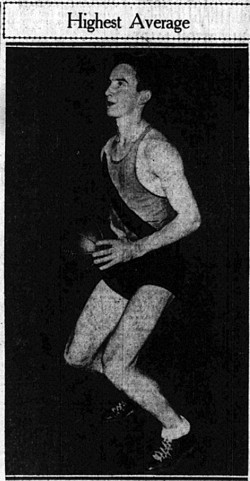 |
|
|
"The exodus of Hank Crisp's Alabama team following close in the wake of the dual elimination of Tech and Georgia Thursday night, proved that anything can happen in basketball. The Mississippi team, which was the first to arrive on the scene of the tournament and the about the last to be noticed; had fallen before the Alabamans by a 41-16 score as recently as last Monday night. But Ray Dauber, the State coach told his boys to go out there and forget about the tournament. 'Just keep hounding that ball and play your own game,' Ray told them." - ("Alabama Bows in First Upset to Delta Team," by Jimmy Jones Atlanta Constitution, February 26, 1933.)
"Mississippi State, of course, looked very fine indeed against Alabama. It was a smooth and beautifully coherent quintet, but it took only half an eye to see that Alabama was sluggish and dragging underneath its own lack of inspiration. Something must have happened to Hank Crisp's team, which looked so potent a fortnight ago, and which, in fact only a few days ago overwhelmed the very team which beat it easily Saturday afternoon." - ("Kentucky-L.S.U. . . .," by Ole Timer Atlanta Journal, February 27, 1933.)
"George (Sofy) Pillow, otherwise known as Grand Larceny Pillow, is one of the outstanding guard of the tournament. This Mississippi State phenom is a ball thief, if we ever saw one. His ability to take the basket ball away from some opponent is positively uncanny. Never have we seen a more blank expression on a man's face than on Ben Smith's countenance Saturday afternoon. The Alabama giant, and Rose Bowl hero, was dribbling the ball towards the basket. Suddenly he blinked his eyes and realized that he no longer had it. Grand Larceny Pillow had held him up without a gun and separated him from the big ball." - ("Sportanic Eruptions: Two Great Battles Tonight," by Morgan Blake Atlanta Journal, February 27, 1933.)
Game 7: Vanderbilt 28, Tulane 25
|
|
"Tulane made Vanderbilt look bad in the first half and had a lead of 11 to 9 over the favorites at the intermission. And with just a minute to go the Greenies were out in front, 25 to 24. Two desperate field goals by Fortune and Foster put the Commodores 3 points ahead at the gun." - ("Miss. State Sensational in Big Upset," by Morgan Blake Atlanta Journal, February 26, 1933.)
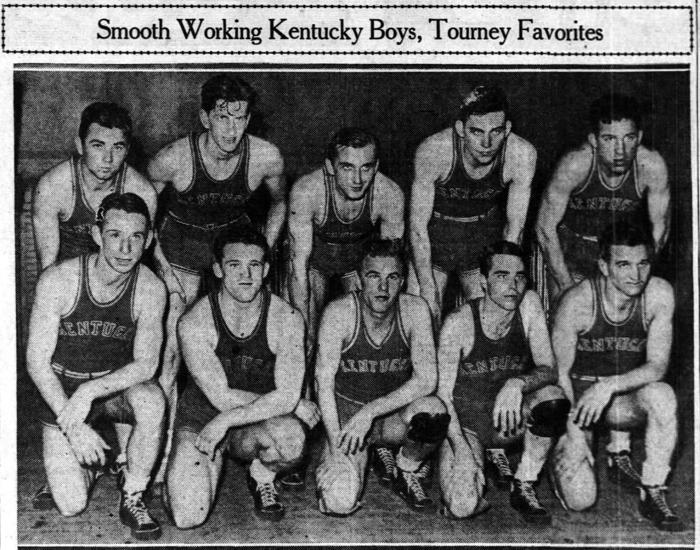 |
Game 8: Kentucky 48, Florida 24
|
|
"A detail of the Kentucky-Florida game would be little more than a repetition of the names, Sale, Demoisey, Davis and Tucker. Florida entered the game keyed up to a high pitch but did not have the skill or speed to stop the Kentuckians. With Sale getting nearly every tip, and with Johnson and Davis feeding smoothly to the slender and frail-looking Demoisey with his tremendous height and to the more rugged and equally tall Forrest Sale, Kentucky ran up a score of 12 to 4 before the Goths got a basket from the floor." - ("Kaintuck and L.S.U. Enter Semi-Finals," by Ole Timer Atlanta Journal, February 26, 1933.)
"Ellis Johnson, Kentucky's tireless guard, has given the most consistent exhibition of performing since the tournament opened. Johnson, half-back of the football team and running guard on Adolph Rupp's court machine, is the only Wildcat player left in to play the entire game, no matter what his team's score may be. He is the master 'feeder' for Sale and Demoisey, the main scorers, and is ably seconded by Wee Willie Davis, the other guard who is on the order of L.S.U.'s Sparky in make-up." - ("Alabama Bows in First Upset to Delta Team," by Jimmy Jones Atlanta Constitution, February 26, 1933.)
"After the game a basketball authority said to me, 'Kentucky may not realize it because the Wildcats won so easily, but they defeated a team that could whip almost any club in this tournament.'" - ("Down in Front," by Brownie Leach Lexington Leader, March 3, 1933.)
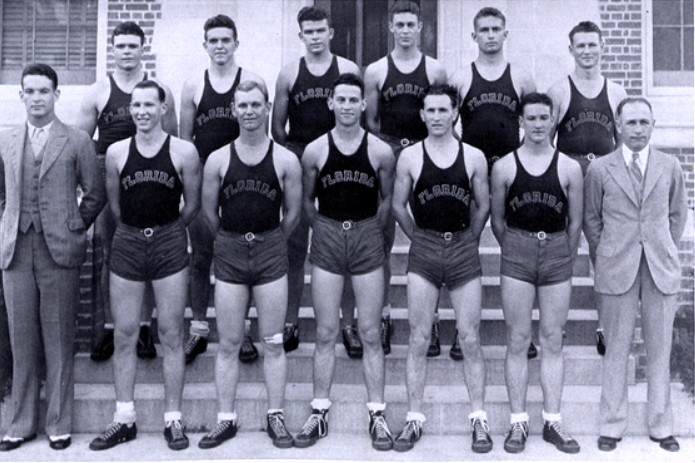 |
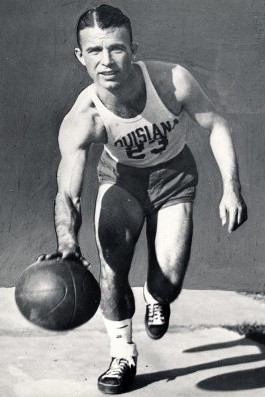 |
|
|
"It was evident Tennessee entered the game with the predetermined purpose of getting the goat of little Wade, the conference clown. That sounded plausibly like good strategy and Red Kirk, as little and almost as quick and fast as Wade, began to ape and mock him from the very start. He did a good job of it, imitating Sparky's mannerisms with just enough exaggeration to make it first-rate burlesque. The two of them got the crowd to roaring with merriment and while Kirk did not upset Wade very much in the long run, at times he turned the laugh directly on the little Louisianan. It may be he cooled Wade off a bit. Certainly Sparky lost some of his ginger at times, but that may have been due to the fierceness of the play which gave little leisure for horse-play. Wade eliminated some of his foolishness and gave thrilling exhibitions of lightning-fast dribbling, rifle-like passing, and several fine shots from afar." - ("Kaintuck and L.S.U. Enter Semi-Finals," by Ole Timer Atlanta Journal, February 26, 1933.)
![]()
Monday, February 27, 1933 - Semifinals
Game 10: Mississippi State 48, Vanderbilt 36
|
|
"The Mississippi Staters showed the same qualities against Vanderbilt they had employed to beat the highly favored Alabamians. In perfect physical condition, and buoyed up by fine competitive urge, they teamed well with Buford Taylor, their great center, and Frank Waites, a brilliant marksman. They got the jump on Vanderbilt and the best efforts of Commodores, known for their ability to 'stretch' were futile against them. Taylor got nearly every tip, and nearly every rebound from the backboard, and he and Waites retained their eyes for the basket." - ("Kentucky and Mis. . .," by Ole Timer Atlanta Journal, February 28, 1933.)
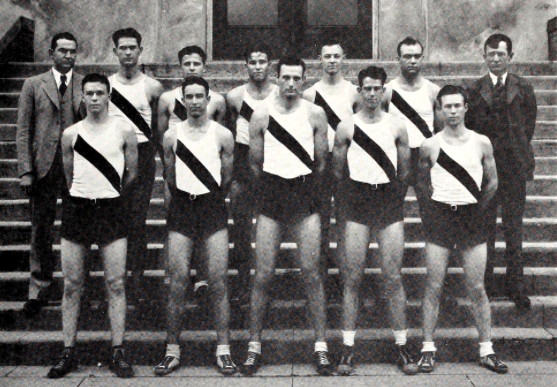 |
Front Row (left to right): C.B. House, Frank Waits, Buford Taylor, Buster "Slim" Cassibry, George Pillow Back Row : Head Coach Ray Dauber, Clyde Sylvester, Whitfield, Marcus Wiehman, R.F. Cochran, Harvey Merrell, Noble |
Game 11: Kentucky 46, Louisiana State 38
"At any rate, the Kentucky-L.S.U. battle should be one of the finest in the long history of the tournament. The teams contrast sharply in physique and in style of play and both are made up of dashing and colorful players.
It's a reasonable guess that the center play will prove the deciding factor. Good basket ball men say that most games are won and lost at that position."
Kentucky's camp followers swear by the beard of Allah that Forrest Sale, their center, is the finest college basket ball player in America today. He is six feet five and in contrast with his soul-mate, Demoisey, is well-muscled and strong. Demoisey, with about the same height, is skinny and frail-looking and wears on his face an expression of abject misery. He seems always just bout to collapse." - ("Kentucky-L.S.U. . . .," by Ole Timer Atlanta Journal, February 27, 1933.)
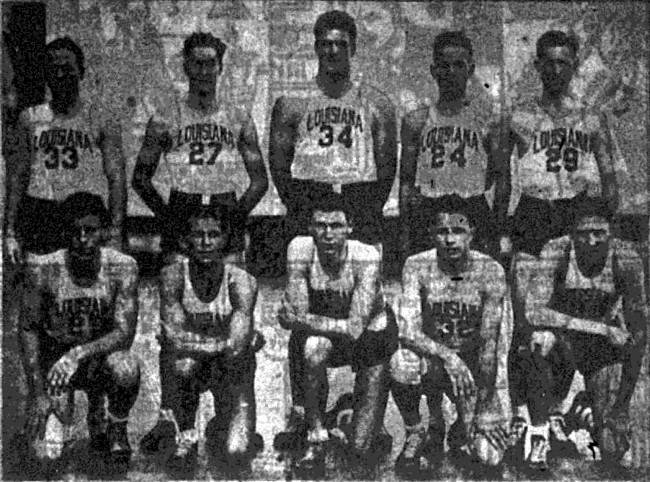 |
Back Row: Smith, Blair, Torrance, Journeay and Harris |
|
|
"The game was scarcely under way before Aggie Sale, the tall, long-striding center of the big blue quintet, was in action. He dribbled under the basket twice in succession to drop the ball through the netting with no one near him and gave his team a lead that the panting and frantically struggling Tigers never could quite catch up with. Sale, the tournament's high scorer, tacked on 20 more points last night, while DeMoisey, the lean lanky forward with the carrot-colored hair, pivoted 17 though he hoop. . ." - ("Kentucky and Mississippi State in Tourney Finals Tonight," by Jimmy Jones Atlanta Constitution, February 28, 1933.)
"Kentucky had to be good to subdue the Louisiana Staters. For, say what you may, little Sparky Wade was a ball of fire, and Nathan Blair a superb shot and a brilliant floor man. Sparky had no time for comedy. His team was up against it and the little fellow soon found out he would have to use to the utmost every talent he possessed. And he almost alone, kept his team from being routed. What a great little fellow he is - clean as a hound's tooth in his play, skilled beyond 998 out of a thousand, and with speed that never slackens and a competitive spirit that never falters." - ("Kentucky and Miss . . ." by Ole Timer Atlanta Journal, February 28, 1933.)
"The passing of Sparky Wade from the tournament took away its most colorful performer. The auditorium was almost packed last night with the crowd which had come primarily to see Wade and his boy friends in action against the veteran Wildcats. Sparky scored 15 points and Blair 13 to lead the Tigers' scoring." - ("Kentucky and Mississippi State in Tourney Finals Tonight," by Jimmy Jones Atlanta Constitution, February 28, 1933.)
"I am very sorry we could not win but we were beaten by a much better team. Sale is the best center I have ever seen, not excepting either Stretch Murphy or Lindy Hood of Indiana and Alabama respectively. He is an All-American," - ( Letter from Sparky Wade to Atlanta Constitution editor Ralph McGill. Mentioned in "Down in Front," by Brownie Leach Lexington Leader, March 1, 1933.)
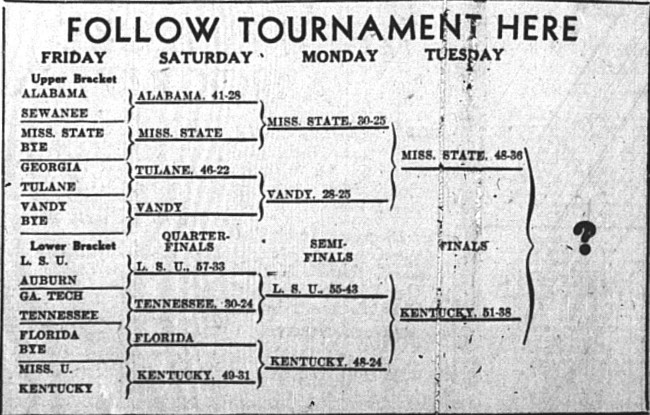 |
"The semi-finals were played before one of the largest crowds in the history of the Atlanta classic. It was amazing when you consider that there was no local entry. Atlanta people, it seems, depression or no depression, will attend any performance of class whether it be football, basket ball, a motion picture, or a violin concert. And yes sir, they'll pack a church if a great preacher is scheduled." - ("Sportanic Eruptions: Battle of Century Tonight," by Morgan Blake Atlanta Journal, February 28, 1933.)
![]()
Tuesday, February 28, 1933 - Finals
Game 12: Kentucky 46, Mississippi State 27
|
|
"In taking the tournament title back to Lexington for the first time since they won the old S.I.A.A. in 1921, the Kentuckians left little doubt as to their mastery of the court. and if Governor Ruby Laffoon should decide to bestow a colonely and a broad-brimmed hat upon each of them when they return to their native state they would carry the honor with just about as much dignity as any colonel has.
"The annual heir-apparents, when they finally became kings, were as gracious with the honor as they were determined in acquiring it. Every man on the team shook hands with the vanquished Mississippians from Starkville, and Coach Rupp came over to the losers' bench where Coach Ray Dauber had been sitting with his chin cupped in his hands and his pipe grown cold to commend him for his fine showing in this tournament which gave his team little, if any, recognition at the start." - ("Wildcats End 3-year Drive for Top Place," by Jimmy Jones Atlanta Constitution, March 1, 1933.)
"Mississippi State basketball players saw more blue uniforms last night at the auditorium than their granddads did in '61." - ("Break of the Day," by Ralph McGill Atlanta Constitution, March 1, 1933.)
"Bet there was a hot time in old Lexington Tuesday night when the final returns were in. The fans up there take their basket ball real seriously. Play-by-play details of all the Kentucky games were sent by wire, and two theaters were packed with enthusiastic crowds. Their faithfulness was at least rewarded." - ("Sportanic Eruptions: Which was Greatest ?," by Morgan Blake Atlanta Journal, March 1, 1933.)
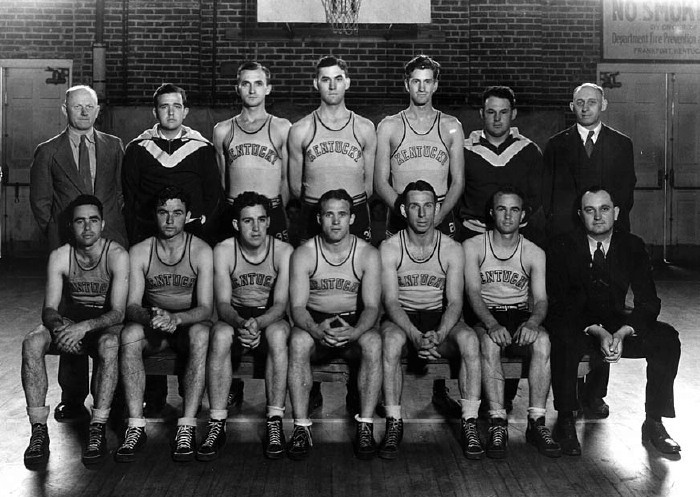 |
Seated (left to right): William Davis, Dave Lawrence, Jack Tucker, Ellis Johnson, Howard Kreuter, Evan Settle, Head Coach Adolph Rupp Standing: Athletic Director Stanley A. Boles, Manager Charles Maxson, George Yates, Forest Sale, John DeMoisey, Assistant Coach Len Miller, Trainer Frank Mann |
![]()
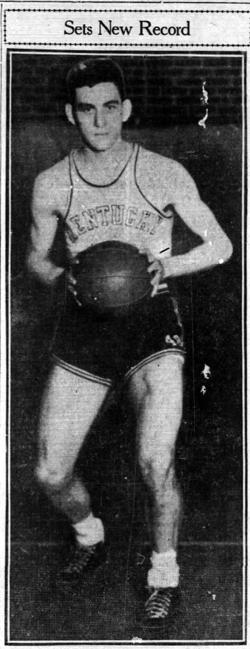 |
First Team
John DeMoisey - Kentucky
Frank Waits - Mississippi State
Forest Sale - Kentucky
Ellis Johnson - Kentucky
Sparky Wade - Louisiana State
Second Team
Buddy Blair - Louisiana State
Jack Harris - Louisiana State
Buford Taylor - Mississippi State
George Pillow - Mississippi State
Bill Davis - Kentucky
"Not only that, Forrest Sale, the answer to a coach's prayer in physique, demonstrated that he was the fastest, most skillful and best poised basketeer ever seen in these parts.
"That is no ex parte or individual opinion born of enthusiasm of the moment. Veteran observers said they had never seen the equal of this powerful young man, six feet five inches tall, who moves with the celerity of the wind up and down the court, who keeps ever in mind a picture of the disposition of forces ont he floor, who shoots with unerring accuracy, and who anticipates every move of his mates and of the opposition.
"Such a clam and cold-eyed observer as Herman Stegeman himself a great player once and a coach of fifteen years' experience, said without reservation after the game that sale was the best basket ball player he had ever seen collegiate or professional." - ("Kentucky and Mis. . .," by Ole Timer Atlanta Journal, February 28, 1933.)
While the Southeastern Conference was determining their champion in Atlanta, the remaining members of the Southern Conference were crowning their champion in Raleigh, as the South Carolina Gamecocks, led by Freddie Tompkins, overcame the Duke Blue Devils 33-21 for the crown.
There was still discussion and comparisons of the teams around Atlanta. Noted Morgan Blake of how the Kentucky team stacked up against UNC teams of the past:
"That old Tarheel aggregation which included Carmichael, Cobb and McDonald, has generally been accorded the laurel of the best basketball team in the history of the Atlanta tournaments.
"Since the present Kentucky flashes rode rough-shod over all opposition, many have changed their opinions and rate the Wildcats of '32 and '33 as the outstanding of all time.
"It would assuredly be a real battle of the century if the old Tarheels could return to the court in their prime again, and battle the Kentuckians of the present era." - ("Sportanic Eruptions: Which was Greatest ?," by Morgan Blake Atlanta Journal, March 1, 1933.)
Earlier Blake had expressed some regret that many of the old schools from before the conference split were no longer present. Wrote Blake:
"The always interesting teams from the Carolina's, Virginia and Maryland have been missed in this tournament, especially the North Carolina Tarheels. They have been such important factors in so many of the Atlanta meets that their absence has somewhat taken the strawberries out of the shortcake." - ("Sportanic Eruptions: Vale Tech And Georgia!," by Morgan Blake Atlanta Journal, February 25, 1933.)
As for Kentucky, after the tournament was over the Wildcats announced that they had been invited and were considering attending the National A.A.U. Tournament in Kansas City the following week in early March. However the decision was left in the hands of the school's athletic council. UK ended up not attending the event, most likely due to the loss of classroom time, given that the Wildcats had already been off-campus for an extended time period due to the tournament in Atlanta. The champion of the AAU tournament ended up being the Diamond DX Oilers of Tulsa OK, led by Chuck Hyatt and Carl Larson.
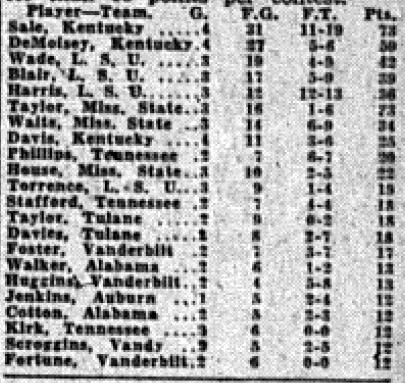 |
During the tournament, the Presidents of the Southeastern Conference schools met and created a new constitution and by-laws. The primary advancement was to define the exact scholastic requirements needed for athletes to remain eligible. This included both the minimum grades along with a minimum residency at the school. The use of scholarships was agreed upon to be in control of the University Administration (whereas previously they were in the hands of athletic boards), although purely athletic scholarships were not allowed.
Another agreement was to allow for limited scouting of future opponents by no more than two games. A complete ban on scouting was considered but this was considered unrealistic given that it gave rise to uneasiness that an advantage could be gained if some schools abided by the rule while others ignored it.
The schools twice voted down an application by Loyola (New Orleans) to be admitted to the conference.
Another potentially significant decision was to decide to abolish all championship tournaments and games. The idea was there was too heavy an emphasis on championships. However this decision was overturned for some sports when the Presidents realized that abolishing all championships would place an even greater emphasis on football than there already was.
The basketball tournament was reinstated, with the site once again determined to be Atlanta. Entering discussions, there was talk that other cities may be considered to host the tournament, such as Lexington (KY), Birmingham (AL), Knoxville (TN) and New Orleans (LA). Noted chairman of the basketball committee (and one of the founders of the Atlanta tournament) H.J. Stegeman: "...the smaller and more compact group of the new Southeastern conference makes possible the rotating of the tournament site, which was impossible when the old Southern conference, of 23 members, was in existence." ("Conference to Decide Next Tournament Site," by Ralph McGill, Atlanta Constitution, February 26, 1933.)
Despite the new possibilities, in the end Atlanta was chosen to remain host of the tournament for the following 1934 season. Noted Ralph McGill, "The officials felt that Atlanta was the only logical site for the tournament and this impression was heightened by the great crowd of Monday night in which there was not a single local team." ("Southeastern Votes to Hold Tourneys in '34," by Ralph McGill, Atlanta Constitution, February 28, 1933.)
The conference track meet was to be held in Birmingham, AL. Other minor sports were not so fortunate, as they were cut. This was primarily a financial decision as none of these minor sports competitions generated money.
![]()
 |  |  |
| 1932 | Main | 1934 |
![]()
Please send all additions/corrections to